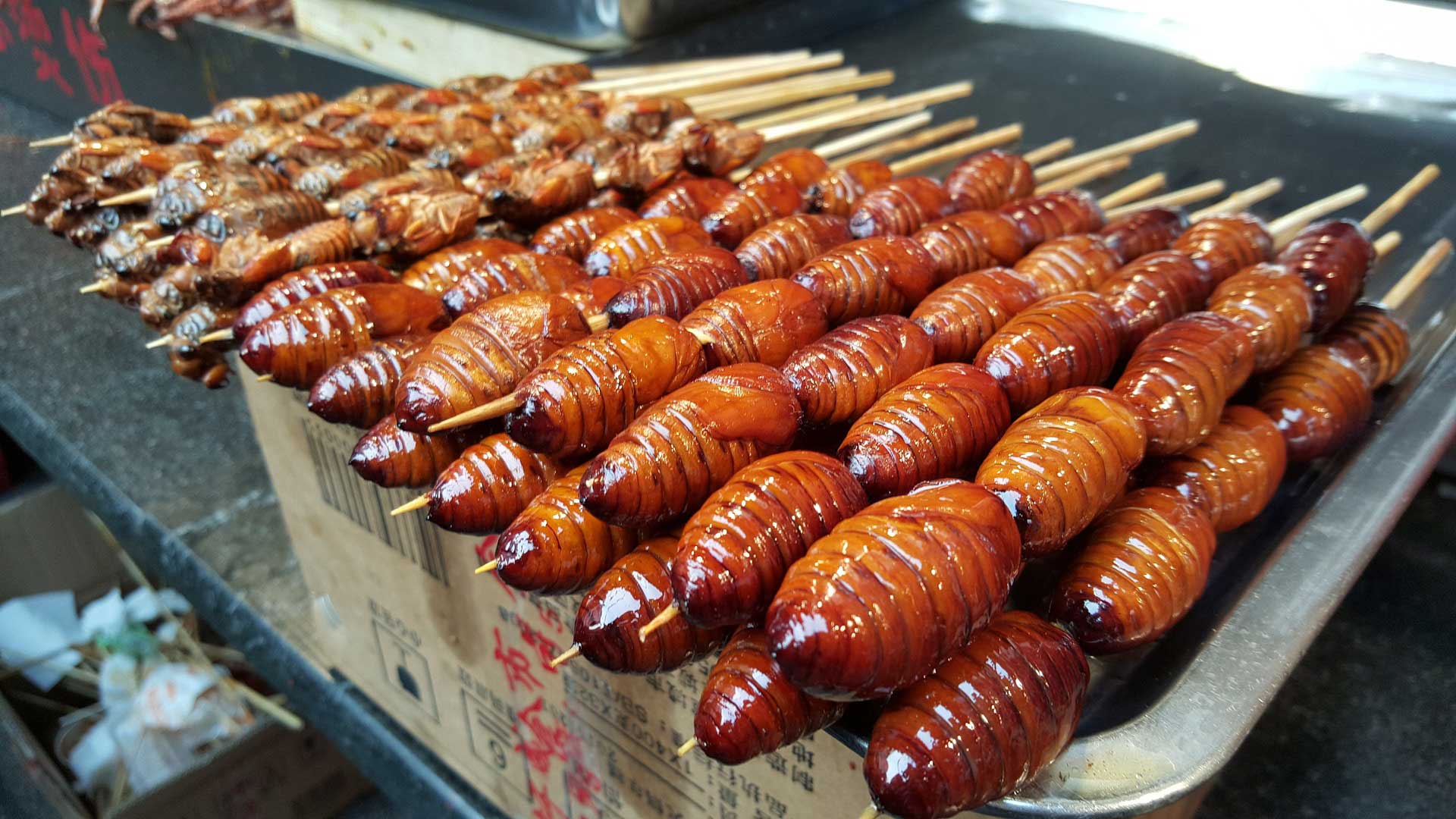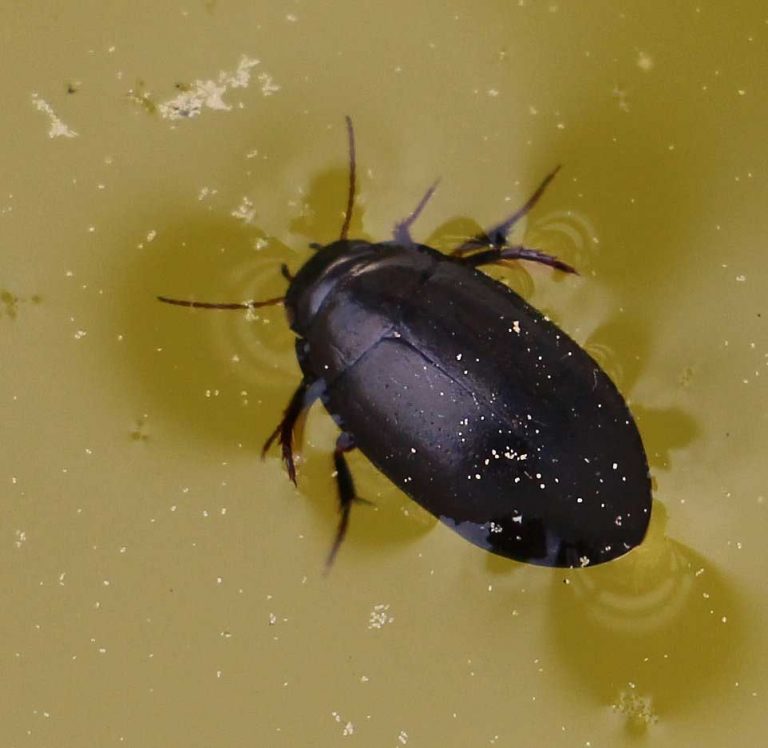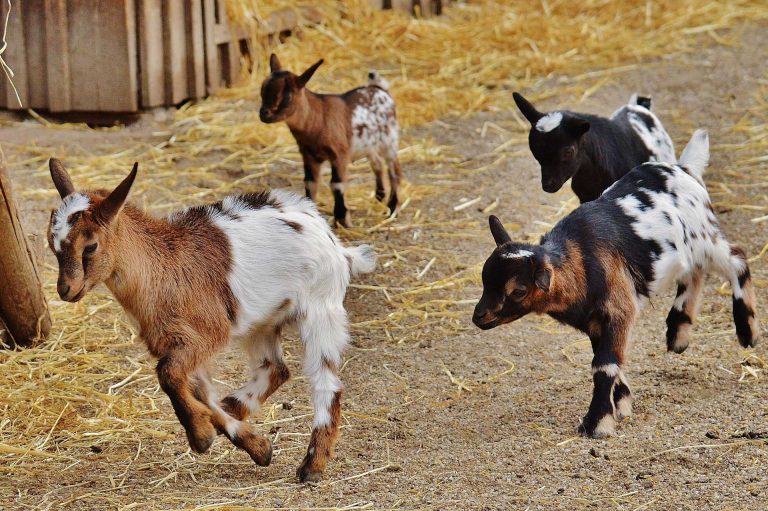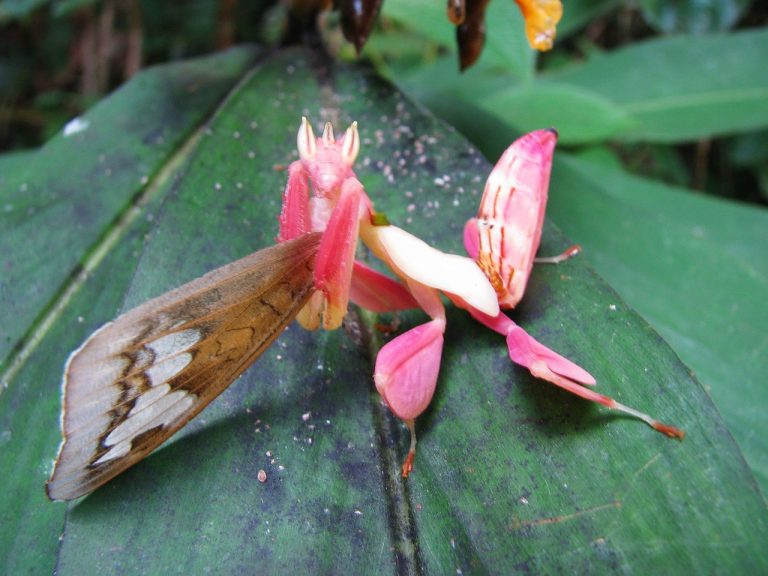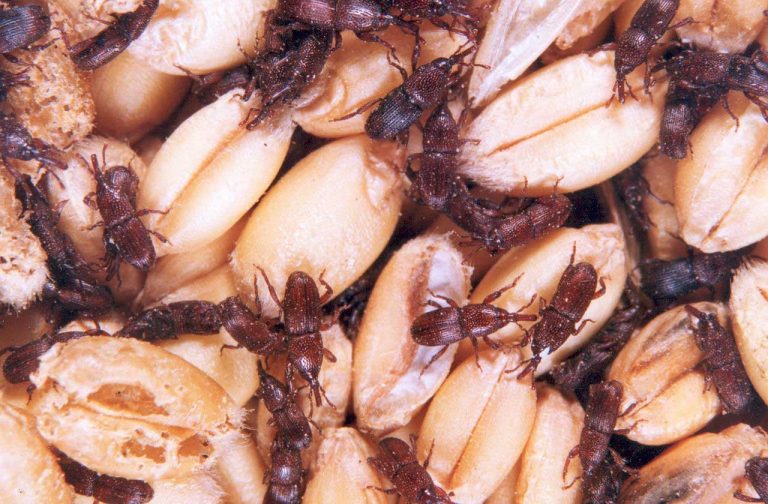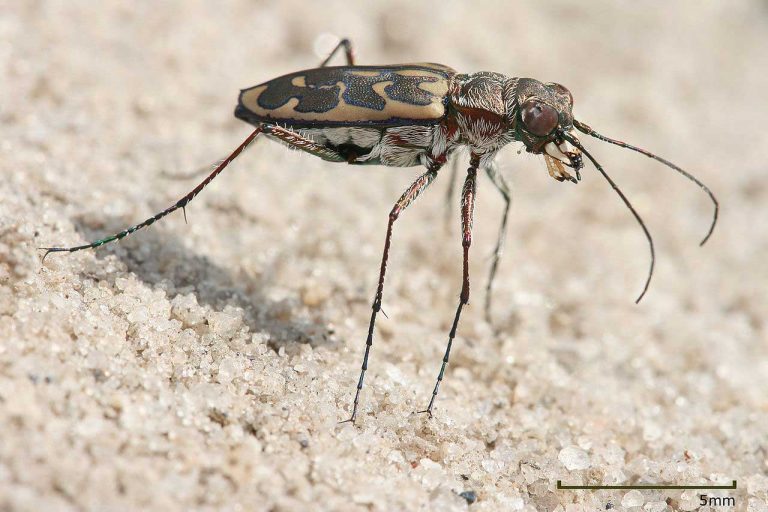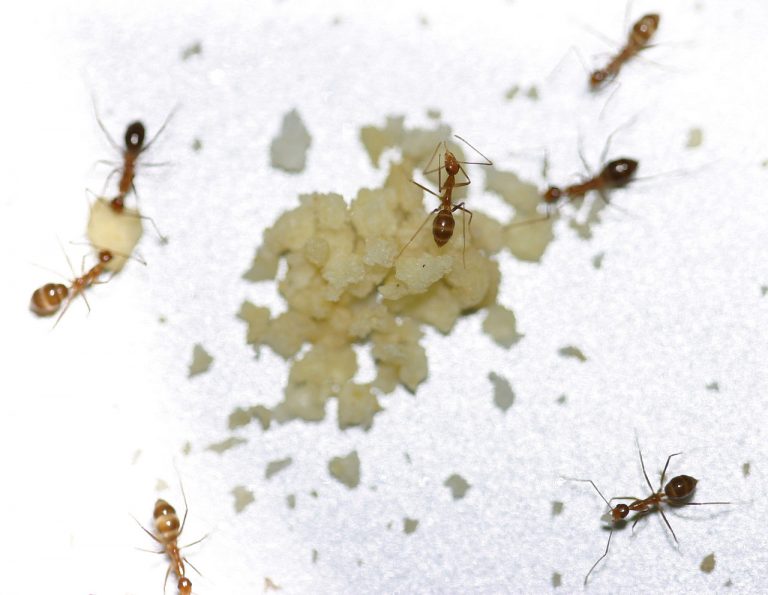Larvae & Insects
Crickets belong to the family of Gryllidae (the other name is “true crickets); these insects belong to the group of grasshoppers. The body shape of the Gryllidae is cylindrical, with long antennae and round heads. It has a robust and smooth pronotum (Wikipedia-prominent plate-like structure that covers all or part of the thorax of some insects) behind its head, At the end of the abdomen, there is a pair of long spikes called cerci; the females possess long ovipositor, cylindrical in shape. The thigh (femora) of the hind legs is enlarged; this gives it the strength to jump. The wings at the front are tailored leathery elytra (wing cover) and tough, the chirping sounds of some crickets are when they rub this part together. The hind wings have a membrane and it is used for flying, when not in use, it is folded. Most of these varieties are unable to fly. The bull crickets (Brachytrupes), are the biggest members belonging to the family with a length as long as 5cm. (2in.).
There exist over 900 varieties of crickets; Gryllidae is found everywhere in the world, other than places of latitude 55o or greater. It in the tropical regions, we see the range of varieties. Their habitats vary from bushes, grasslands and forests to also in beaches, marshy places and in caves. Generally crickets found are nocturnal, the males are well known for the loud chirping sound continues without stop. This sound is to entice the females; however, certain varieties are mute. The varieties that sing possess good hearing capacity, through their eardrum (called tympani), are situated on the front legs.
The male crickets establish their supremacy through violence, which begins by lashing one another with their antennae and by flashing their mandibles. Till one surrenders, they continue fighting, simultaneously producing cells quite different from the normal. The one, who attains dominance, sings in a loud voice, whereas the other observes silence.
Females in general attract their males through their calls, but in the non-stridulatory (Wikipedia-act of producing sound by rubbing together certain body parts.) species, they use a different mechanism for this. Following the contact through their antenna, perhaps, there is a period of courtship; at this time; the nature of the call becomes different. When the female rises on the male, a single spermatophore gets transferred to the female external genitalia. The flow of sperms into the oviduct of the female continuous from minutes to an hour, this varies according to the species. Once copulation is complete, the female is likely to either eat or discard the spermatophore; males use a variety of ritualized behaviors to avert this. On many occasions, the female mates with different males.
The majority of female crickets lay eggs inside the plant stems or in the soil, by using their lengthy saber-like or needle-like egg-laying organ, which is called an ovipositor. Certain species that live on the ground have done away with this, depositing their eggs either in an underground chamber or pushing them in the burrow walls. The cricket having a short tail (Anurogryllus) digs a burrow, making chambers, and creates a place for discharging their body excreta, then lays its eggs in piles on the floor of the chamber, and when the eggs hatch, it feeds the juveniles till almost a month.
Cricket Farming
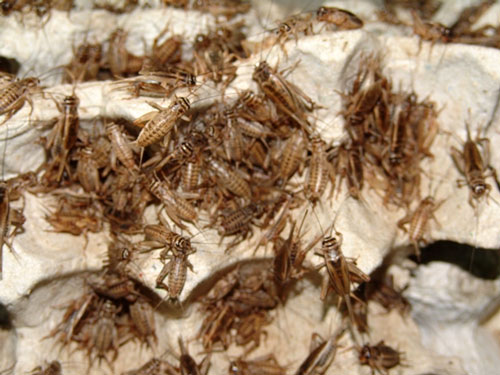
In the southern part of Asia, including Vietnam, crickets are commonly eaten as a snack, prepared by deep frying the soaked and cleaned insects. The food conversion efficiency of house crickets (Acheta Domesticus) is reported to be five times higher than that for beef cattle, and if their fecundity is taken into account, fifteen to twenty times higher.
In America, it is a practice of incorporating farmed crickets in the form of protein bars, protein powder and baked goods; the objective is to satisfy the customers for losing weight, if not for reducing damage to the environment. Cricket farming is done in a big way for feeding laboratory and carnivorous animals. In order to give the predators like tree frogs (Hylidae) a balanced diet, they are gut loaded with supplementary minerals, like calcium.
Of late, small farms have started mushrooming in the form of consulting firms that take up building farms for fresher’s and designing and seeking employment with existing growers, such as Big Cricket Farms, that were started in Youngstown, Ohio, in the month of April in the year 2014. The predicted production is almost 16 tons of crickets in a year in a space of 5,000 sq. Ft.
At present, small companies are expanding their core technologies in the form of template to equip the latest insect farms, and instilling hope in the young entrepreneurial new farmers, giving them a feel of demand. The purpose is to optimize these inputs in the form of water and food, with the use of “precision agriculture” techniques, by a technology in use by the soy and corn farmers that helps in the cause of joining farmers with regional and local suppliers. The reason is insects do not require much space; it is easy for growing them in the vicinity of the customers.
Cockroaches
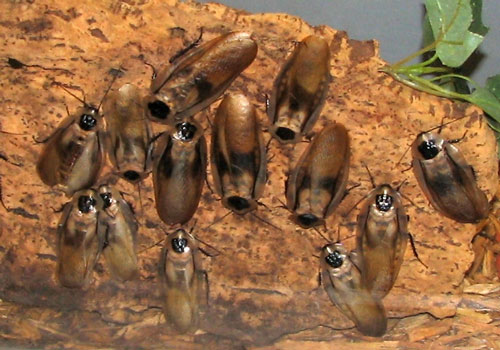
Photo by: Trisha Shears
Cockroaches come under the category of Blattodea and at times they are named Blattaria. Among these 30 species from amongst the 4,600 belong to human habitation. From these somewhat four species are famous pets. The American cockroach, called Periplaneta Americana is one among the popular species of pets; it is almost 30 mm (1.2in) in length; The German cockroach, called Blattella Germanica, is about 15 mm (0.59in.) length. The Asian cockroach, Blattella Asahinai, too, is almost 15mm (0.59 in.) in length. And the Oriental cockroach, named Blatta Orienyalis is almost 25 mm. (0.98 in.) long. The cockroaches in the tropics are mostly bigger in size and, in contrast to public opinion, the relatives of the cockroaches that are extinct, and the ‘roachoids’ like the Permian, Apthoroblattina, Carboniferous and Archimylacris did not exceed in size of the biggest one of the modern species.
Most of the varieties of cockroaches are of a thumbnail’s length;, however, many varieties are larger. The Australian giant burrowing cockroach called Macropanesthia Rhinoceros is the world’s heaviest one, it weighs over 30 gm. (1.1 oz) and measures nearly 8cm (3.5invhes.) in length. The Central American giant named Blaberus Giganteus is somewhat the same size, its length is almost the same, but weight is not that much. As per the Guinness world records, the species of cockroach that is the longest is the Megaloblatta Longipennis that can grow to a length of up to 97mm (3.8 in,) with a width 45mm (1.8 in.) The wing span of the Central and South American species, named Megaloblatta Blaberoides is the largest; it is 185mm (7.3in.)
The bodies of the cockroaches are flattened and broad, with comparatively small heads. They are the most common insects, of which just a few are adaptive. It perhaps belongs to the very primitive existing Neopteran insects. The parts of the mouth is situated beneath the head, it includes the usual chewing mandibles. They possess two Ocelli, big compound eyes and an antennae that is flexible and long.
Cockroaches make use of pheromones for attracting their males; the males practice courtship rituals, like stridulating and posturing. Similar to the other insects, while the cockroaches mate, their faces are opposite to each other, keeping their genitalia in contact, their copulation is prolonged. Certain varieties reproduce in the absence of a male. They are called parthenogenetic. Normally the female either attaches the case of the eggs to a substrate, and then places it into a convenient, safe crevice, or carries the eggs with it until they hatch. Certain varieties are ovoviviparous, which means, they keep the eggs inside its body, either with or without an egg case, till they hatch. One genus, Diploptera is completely viviparous.
The nymphs of the cockroaches are like their adults, with the exception of undeveloped wings and the genitalia. They develop gradually and perhaps take some months or even a year to mature. The adults too live long, and statistics show that they survive for even 4 years in laboratories. In China, cockroach production is spearheaded by a man who is 43-year old and has the largest business, (perhaps in the world.), with 6 farms, with a population of 10 million cockroaches. They are sold to producers of Asian medicines and to companies manufacturing cosmetics; they have value as a cheap source of proteins and of the substance like cellulose on their wings. American cockroach or Periplaneta Americana is the preferred breed. This cockroach is reddish in color and grows to a length of 1.6 inches. Contrary to the dark, smaller and wingless German cockroaches, these cockroaches are able to fly when mature.
There are almost 100 cockroach farms in China, and fresh ones are starting, corresponding to the proliferation of these critters. However, as far as the Chinese industries are concerned, they had not much knowledge on the subject. A million cockroaches escaped from a farm Jiangsu province. This Huge Escape, created headlines in and around China and further, many compared it to the biblical descriptions of abundant locusts.
In some very special farms in China, the cockroaches are fed for four months with wheat shavings and vegetables. When they are grown, they boil, dry and crush them and some are converted to pill form for hassle free intake. Most roaches in China serve the medical industry and are reputed to cure any problem pertaining to the lungs, heart and the liver.
Grasshoppers
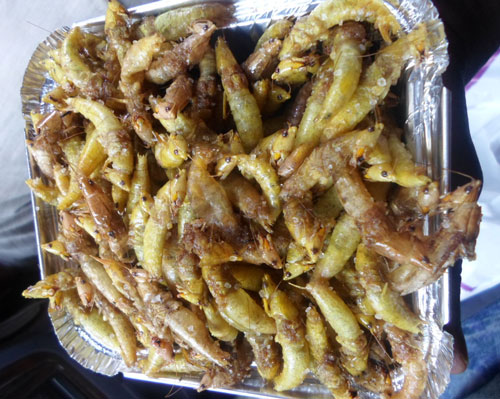
Photo by: Erina Mukuta
Grasshoppers belong to the category of Orthopters, the subgroup is Caelifera. Occasionally they are considered as short-horned grasshoppers, in order to discriminate it from the katydids (called bush crickets) that have very much longer antennae. They are characteristic insects that live on the ground; they have powerful hind legs; they leap vigorously, which enables them to flee from their threats. They belong to the hemimetabolous variety of insects. (That never undergoes total metamorphosis). They hatch from eggs into hoppers or nymphs that undergo 5 molts. At every stage of development, they resemble the adult insect. Where the population is dense, in particular surroundings, certain varieties of grasshoppers are able to change their behavior and color and the form swarms. In such conditions they are called locusts.
The grasshoppers eat plants, occasionally; they are also severe pests of vegetables, cereals and pasture, particularly when they swarm in their millions in the form of locusts and devastate crops. Camouflage helps them to be safe from their predators; if they are noticed; several varieties try to alarm the predators exhibiting their brilliantly colored flashing wings while they are jumping and (in case they are adults) they launch themselves in the air, normally they fly just over a short distance. Other varieties like the rainbow grasshopper, whose colors signify danger, drives away their enemies. Grasshoppers are susceptible to a wide range of diseases, including parasites. The nymphs and the eggs are food to many creatures like predators and parasitoids that feed on their eggs. The peculiar shape of the grasshopper’s thorax, head and abdomen resembles that of a typical insect. They hold their heads upright, inclined to the body, keeping their mouth held downwards. The grasshoppers have a big pair of compound eyes, which gives them a panoramic vision, a pair of eyes, resembling threadlike antennae, sensitive to smell and touch and three ordinary eyes capable of detecting darkness and light. The portions of the eyes that are directed downwards, are adapted for chewing, they also possess two palps in the jaws at the front that are palpable.
The abdomen and thorax are made of segments with a firm cuticle, arranged in plates, composed of chitins that overlap one another. 3 of the thoracic segments are fused together; they have 2 pairs of wings and 3 pairs of legs. The hind wings are huge and made of membranes; they gain strength through the veins, while the wings that are at the fore end are leathery and narrow, and they are called terminal. At the terminals of their legs they have claws used for gripping. They have powerful hind legs, they have a tough femur, with many edges, it is here various surfaces are joined in certain varieties, and the inner edges have stridulatory pegs. At the posterior rim of the tibia, there is a double row of spines, and adjacent to the lower terminal, they have two articulated spurs. The muscles that regulate the limbs are housed within the thorax.
In summer months, normally, the Grasshoppers lay their eggs in ponds at the bottom, adjacent to plants that are their food. In certain species, the eggs get stuck to each other by means of a frothy substance. A few weeks into growth, in many species, the eggs enter into diapauses; in this condition, they get through the winter. In certain varieties, the eggs hatch, in the very summer that they lay the eggs. When the ground temperature is very low, the diapauses break. As soon as the temperature of the ground warms beyond the threshold temperature, it resumes its growth. The embryos of a pod will hatch within a few minutes, subject to small differences in time. As soon as they are hatched, they shed their membranes, following which, their exoskeleton becomes hard. These initial instarnymphs are able to slip away from their predators.
Certain countries consume grasshoppers in their diet. The people of southern Mexico, eat grasshoppers, called Chapulines as different dishes, namely, grasshoppers served as skewers in certain food markets in China, tortillas with chili sauce, Donghuamen Night Market serve grasshoppers, by boiling them and adding salt, In Gunung Kidul location of Yogyakarta (Wikipedia- a city and the capital of Yogyakarta Special Region in Java), they eat sun-dried grasshoppers as snacks and fried grasshopper, called Walloon Goring. The Natives of America, called Ohlones, burn grasslands in order to attract grasshoppers into a pit and gather them for food.
Some do grasshopper farming by following the following simple steps
1) Borrow or rent a plot of land that is distant from agricultural land.
2) Select a species of grasshopper that has seen success in that area.
3) Grow trees and shrubs that are compatible with that particular grasshopper species, and mow all round the perimeter to prevent ingress and egress of the grasshoppers.
4) Now, introduce the grasshoppers in the field, before which you may have to make arrangements grow eggs and nymphs.
5) Wait and watch as the grasshoppers grow and multiply.
6) Harvesting is done using a tractor and nets to sweep the area inward spiral-wise.
7) Store by freezing,
Locusts
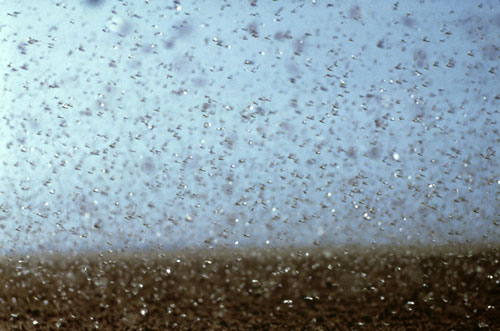
Photo by: CSIRO
It is recorded in the Bible that John the Baptist ate locusts and wild while living in the wilderness; attempts have been made to explain the locusts as suitably ascetic vegetarian food such as carob beans, but the plain meaning of the word alludes to insects.
The Locusts are a group of grasshopper species that becomes gregarious and migratory when their populations are sufficiently dense. During the swarming phase, locusts destroy or severely damage crops. They are a major pest of historical importance, notably in Africa (North, West, Sahelian and Madagascar), Australia and the Middle-East. A locust swarm represents a considerable quantity of biomass, containing up to 10 billion insects and weighing approximately 30,000 tons. The swarming behavior makes the locusts relatively easy to harvest as edible products.
In Africa, the brown locusts (called Locustana Pardalina), the locusts of the desert (called Schistocerca Gregaria) the red locusts called Nomadacris and the migratory locusts (called (Locusta Migratoria), are a general source of food. The Chinese, Japanese and the Koreans harvest the rice field grasshoppers that include the axis, oxya Velox, yezoensis, Acrida Lata and the Oxya Sinuosa species for their food. In Mexico, particularly the Sphenarium Purpurascens, the chapulines (Wikipedia- grasshoppers of the genus Sphenarium, that are commonly eaten in certain areas of Mexico), grasshoppers belonging to the Sphenarium genus, which is considered a pest of Alfalfa plants, are popular as an edible food product. In several regions of Southern and eastern Africa, the grasshopper called Ruspolia Differens, a katydid in the original, is considered a general food item. In South East Asia, Thailand in particular, consumes crickets as a common source of food item People in Thailand eat species like the Acheta Domestica, Teleogryllus Occipitalis, Gryllus Bimaculatus Teleogryllus Mitratus, Tarbinskiellus Portntosus and the Short-Tail Cricket Brachytrupes Portentosus.
Harvesting and Farming
The locusts and the grasshoppers are normally harvested, mostly during night, in the natural environment (with the aid of a torch), if not in the morning hours at cooler temperatures and when the insects are not so much agile it convenient to catch. Since there is a great demand for this, commercial farming of the grasshoppers, crickets and locusts is being farmed where they are consumed and for the feed market in south eastern parts of Asia. In Thailand, the farming of crickets was done for the varieties, including Gryllus Bimaculatus, Acheta Domestica, Orthoptera and locusts in particular for the purpose of feeding the requirements of the zoo and pet animals.
Locust Farming
In India, grasshopper’s research was conducted on the varieties like oxya Fuscovittata, Spathosternum Prasiniferum and Oxya Hyla. Jars having a capacity of 2500 cm3 could accommodate 10,000 creatures in every meter cube of the Oxyafuscovittata and for Spathosternum Prasiniferum, 7100 insects in every meter cube, with a mortality rate of 12 to 15% respectively.
When compared to the bigger variety such as the Oxya Fuscovittat, lesser space is enough for accommodating the smaller variety called Spathosternum Prasiniferum. As regards the body weight, fecundity and fertility, the Oxyla Hyla shows a better performance than the Spathosternum, and the mortality rate, of the nymph, it is lower.
In case of the annual production of biomass of the two acridids, Brachiaria Mutica is better than Cynodon Dactylon and Dactyloctenium Aegyptium.
Red Palm Weevil
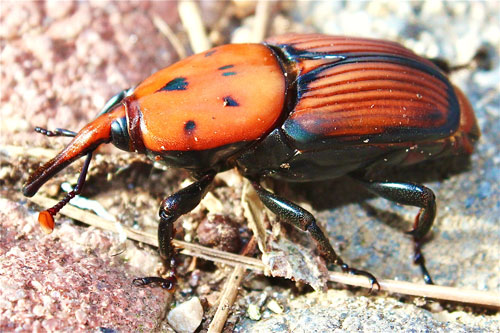
Photo by: Chixoy
The need palm weevil, otherwise named Rhynchophorus Ferrugineus is a particular variety of snout beetle, The other names by which it is called are Sago palm weevil or Asian Palm Weevil. These well developed beetles are sufficiently big and grow to a length of 2 to 5cm; their color is normally rusty red; however we find them in many other colors. This creates confusion in the identification of other species. (An example of this is the Rhynchophorus Vulneratus). These weevils are efficient enough to make holes as deep as I meter in the trunk of the palm tree. This makes the plant weak and ends in death of its host plant, making them the main pest of the palm plantations, including the date palm, oil palm and the coconut palm. Initially, the red palm was widespread throughout Africa and Europe and in 1980s; it was endemic in the Mediterranean. In the year 1994, this was observed in Spain and afterwards in 2006, it was found in France. In places like Sicily, Campania and Tuscany in Italy, plague spread widely. Apart from this it was endemic to the regions of Portugal, especially in the South. Researchers think its infection extended as far as Morocco, Algeria and many other regions of North Africa. But, there is not enough documentation to prove this. It was in the year 2009 that the weevils were found in America on Curacao Island, The same year it was found in Aruba. Later it was seen it the United States in the Laguna Beach, CA in the year 2010.
Larval Grub
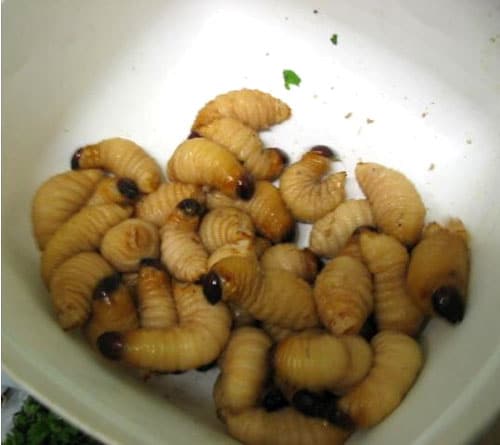
Photo by: Chixoy
Larva grub was considered a most favored dish in several regions of South East Asia. “Sago Delight” or “Fried Sago Worms” are considered a preferred dish in Indonesia, especially in the Eastern regions, such as Maluku. In New Guinea, in Papua, another dish of this variety is regarded it as a delicacy. The characteristics of this Sago grub show that it has the taste of cream when raw and when cooked, it has the taste of bacon or meat. This is normally prepared using sago flour. On particular functions during celebrations in New Guinea, they have worms roasted on a spit, which several tribes of Sarawak, such as the Melanum and the Davak consume either raw or roasted. They regard this as a nutrient rich meal. Apart from this, the Kombai, Asmat and the Korowai people of South Guinea too, regard this in the similar way.
Neonate Larvae
The neonate larvae are segmented and are colored yellow with a white tint. They are legless, they have chitinous capsule shaped heads (of curculionid features), with a darker color than the rest of the body. They have conical shaped strong jaws, laid horizontally, with which they drill holes penetrating through the axis of the leaf to the crown, in this process, they feed themselves sufficiently well. When the larvae are fully grown, they at times emerge from the tree trunk and enter the palm. The larvae undergo metamorphosis and turn into an adult. In addition, the larvae weave a pupal case at the bottom of the palm fronds inside the frond itself or perhaps centralized in the plant base.
Adult
The adult insect is an excellent flier and is able to travel great distances. While they prefer to attack palms that are already infested or weakened by other stresses, they will colonize healthy palms. The rearing of RPW (Red Palm Weevil is an economical business, with regard to labor, production and supply. Besides, they have other sources of income through this production. The primary source of income obtained by the other farmers is through the production of oil palm and rubber. In another case, a farmer a rubber plantation was transformed into oil palm and the farming of weevil turned into the sole income, until when the oil palms started to produce… It is estimated that the cost of 12 rearing containers was 460 BHT and the cost of 1 Kg. pig food at 32 BHT, they harvested sago palm free of cost (a certain farmer from the province of Nakhom Si Thammarat grew RPW for the purpose of selling the developed ones to the other farmers for a price of 1000 BHT, for 25 pieces of weevils of 0.5 m height. For controlling the process of rearing, it takes just a few hours of work a week. In the province of Songkhla, at some weevil farms, the farmers stock the insects in containers and stack them on shelves in cinder block sheds, and earn a benefit of around $24US/m2 of rearing area. Though accurate information about production is difficult to come by, the price for every Kg of larvae as stated by the weevil farmers showed an aggregate of 250 BHT/ kg. If the production of RPW was on a mass scale, it was highly profitable. But the return tends to decrease below the estimated value, with varying demand. According to some farmers, the sales of every day will vary between 1 kg to 10 kg.
Preparation of Weevil Larvae and Pupae for Eating:
The number of methods of cooking larvae and RPW are three.
- Stir-fried in a wok (normal)
- Cooked as a curry dish along with vegetables.
- Battered and deep fried.
Occasionally, live larvae are consumed by dipping them in soy sauce.
A dish of pupae and prepared RPW larvae gives you a substantial and heavy meal on its own or if it is accompanied by rice, vegetables or noodles. Preparation of weevil larvae, as a dish of pupae and larvae is done by soaking them for about 10 minutes in a brine solution at a~10%. Then drain and blanch the larvae for a minute in boiling water, following which, the head capsules of larvae is taken away before cooking. Add the larvae in a hot wok along with vegetable oil and then stir it while frying along with Thai basil, salt, nicely chopped hot chili, soy sauce and black pepper. Cook the larvae till it reaches a light brown color (in about 5 minutes). Take this dish as a snack of finger food, either as a main course along with rice or along with cold beer. The head capsule of larvae which is stirred and fried are crunchy, just like tiny sunflower seeds, they add flavor to your mouth. RPW pupae are superb. Without the crunchy head capsule, with a high content of fat Its consistency and texture is just like butter. Deep fried larvae is a good dish, and in the absence of the head capsule it was difficult for the consumer to understand if the morsel is an insect larvae and it easily takes the place of a calamari or another dish.

Having discovered a fondness for insects while pursuing her degree in Biology, Randi Jones was quite bugged to know that people usually dismissed these little creatures as “creepy-crawlies”.

